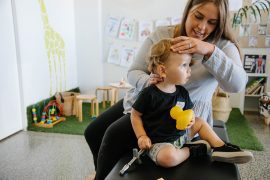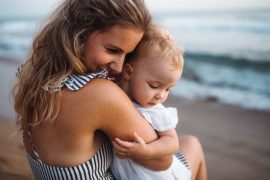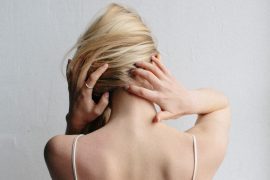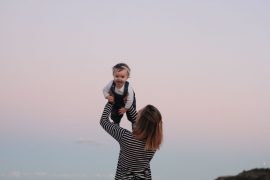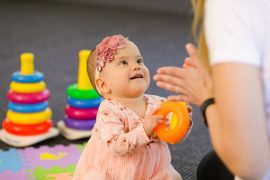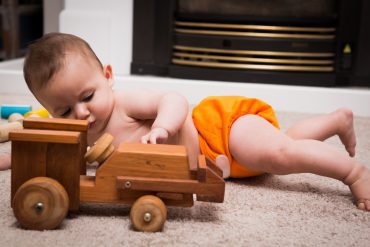Always wash new materials before using as they hold onto excess dye, as well as the pesticides used in transporting from the factory and warehousing. Add ½ cup baking soda to your wash to help strip the residue.
Organic materials are better for the environment. Regular cotton growing takes quite a toll on the environment but unfortunately organic is pricier and not everyone can afford it. If you can’t, or don’t want to, buy organic then look for the BCI (Better Cotton Initative) label – they are working with cotton farmers on being more sustainable and reducing their impact on the environment and are having some great results.
6. Toys: Wood, cloth, natural rubber and food-grade silicone
Plastic toys can contain phthalates, BPA, BPS, PVC or lead. Of these, only BPA is on people’s radars and some products come with a ‘BPA Free’ sticker…. What about the other toxins? These slowly leach out, waiting for your baby to touch or suck the toy and can cause all manner of harm: endocrine disruption, developmental issues and cancer.
Natural material toys are also simpler – they don’t have the electronics, noises and flashing lights of plastic toys. This may seem more boring but research shows that these are better for developing brains because it stimulates creative play and the need to use imagination.
Billions of toys land up in landfill every year as most modern toys can’t be recycled, as they are made of mixed materials. Wood, cotton and natural fibres can last for generations and are then compostable.
Silicone does not compost but it also does not break down into microplastics or leach harmful chemicals into the environment.
7. Nappies & wipes: Re-usable modern cloth nappies (MCN) & wipes
I could write a book on this subject!
Disposable nappies have the dual issue of landfill waste (about 6,000 nappies per baby!!!) and chemicals in them touching that delicate skin. They contain absorbent gels, dyes, phthalates, by-products from bleaching and concoctions to create fragrances. These contain endocrine-, neuro-, and respiratory toxins and carcinogens. Manufacturers state that the levels are acceptable, but smoking was also acceptable and safe!
On the odd occasion I’ve had to use disposable wipes (and I find them so ineffective – you need way more than 1 for poo nappies), they bunch up and fingers are super close to the icky stuff. Cloth seems to ‘grab’ the poo and my fingers feel safer.
Using cloth nappies and wipes can save you a truckload of money – more than enough to spend on that super trendy wooden play castle. Over the nappy life of 1 child (2.5 years), you could save around $4,600. Hell, that’s a holiday!
Another bonus – in the 8 months I have used cloth and just plain water for cleaning, my little one has never once had nappy rash.
8. Cleaning: Natural cleaners, be careful of greenwashing
Don’t go to all the trouble of detoxing your nursery and then undo your hard work by using conventional cleaning products. These cleaning products can leave residues on surfaces which your baby will suck (and they suck on any and everything!) or linger in the air which their teeny-tiny little baby lungs will breathe in.
Buy eco-friendly cleaners but be careful of greenwashing. Products labelled eco-friendly can still contain harmful chemicals, both to humans and the environment as there is no regulation of these claims.
Or make your own and save some moolah – the internet is full of easy recipes: vinegar, baking soda and tea tree oil will pretty much clean anything! (Don’t use tea-tree oil if baby is under 3 months)
9. Re-use: Not everything needs to be new
I know – as an online shop I’m hurting myself by saying this, but it’s gotta be said. You don’t need to buy everything new.
- Reuse what you already have, e.g. put a change pad on top of a chest of drawers instead of buying a change table
- If you buy new, buy so that you can re-use in your home, e.g. a nursing chair that also looks fab in the lounge
- If buying new, buy quality which lasts so that you can pass on to other families when you’re done
- Don’t disregard hand-me-downs. Babies grow so quickly that sometimes they will only wear an item a few times before they’ve outgrown it. You can save yourself a fortune by being in a hand-me-down chain
VOCs and Vinyl/PVC:
Volatile Organic Compounds- VOCs
VOCs are chemical gasses emitted from solids or liquids and are very common in household products. Individual items release VOCs within the acceptable limit, but the compound effect of everything in the home is not considered. Health effects may include eye, nose, throat and skin irritation, headaches, loss of coordination, fatigue, dizziness, nausea, thyroid disruption, reproductive and neurodevelopmental problems, immune suppression and cancer.
Vinyl/PVC
Polyvinyl chloride can be hard or made flexible by adding plasticisers such as phthalates. It is incredibly harmful to the environment and to people due to the high use of chlorine in the production. Chlorine toxicity is linked to infertility, immune system damage, impaired childhood development, hormone disruption and cancer. A by-product of chlorine based chemicals is dioxins, one of the most toxic chemicals ever produced. The EPA states that there is no acceptable level of dioxins and health impacts include reproductive and developmental problems, damage to the immune system, interference with hormones and causing cancer.
Originally published here.
Bronwyn is the founder of Eco Mamas Market. You can learn more about the amazing work they are doing by visiting their website and following their journey on Facebook and Instagram.
Better for your little one, Better for the planet


